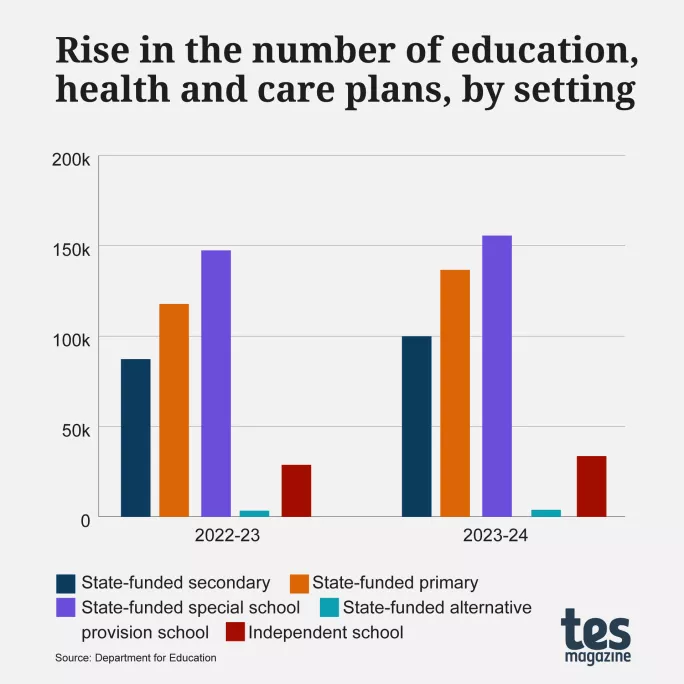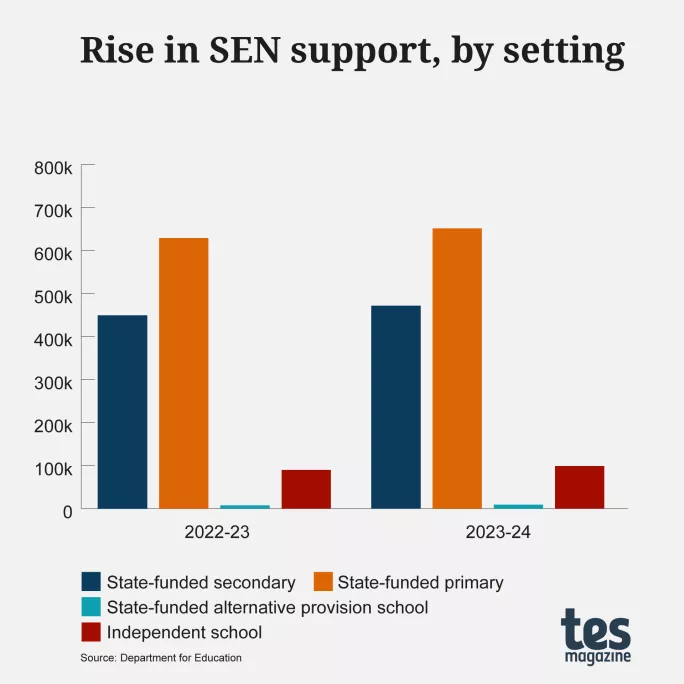
8 SEND and EHCP data insights schools need to know

New statistics on the number of pupils with special educational needs and disabilities (SEND) and education, health and care plans (EHCP) have been published by the Department for Education, offering a raft of key insights for schools around the country.
Here are some of the main headline data points worth being aware of:
1. SEND and EHCP need rises
The number of pupils classed as having SEND - but without having an EHCP - has risen 4.7 per cent to 1,238,851. This equates to 13.6 per cent of the entire pupil population.
Meanwhile, the number of pupils with an EHCP is 434,354 - an increase of 11.6 per cent compared with 2023 data. This represents 4.8 per cent of the pupil population.
In total, this means there are over 1.6 million pupils with SEND - an increase of just under 300,000 in the past five years.

2. Primary and secondary split
This growth has not been uniform, though, with the biggest increases seen in primary schools, where an additional 18,900 pupils were recorded as having an EHCP, up to 136,642 in total. This represents 3 per cent of the primary population.
At secondary, the number of students with an EHCP rose from 87,219 to 99,825, equating to 2.7 per cent of the secondary population.
Finally, 14.1 per cent of primary pupils have some form of SEN support (651,458) while 12.9 per cent do at secondary age (471,677).
3. Special settings
For special schools, almost all pupils have an EHCP, at 99.2 per cent, equating to 155,619 pupils, while 1,166 have SEN support.
Alternative provision settings, meanwhile, have 24.2 per cent of pupils on an EHCP (3,837) - an increase from 3,368 last year - while the number with SEN support has risen to 58.1 per cent (15,866 pupils).
Finally, at independent schools (including special schools), the number of pupils with an EHCP is now 5.7 per cent (33,541) and the number with SEN support is 16.7 per cent (98,969).


4. Types of need
For EHCP pupils, the most common type of need recorded is autistic spectrum disorder, at 132,249, accounting for over 30 per cent of all plans. This is a rise of over 16,000 compared with last year.
Speech, language and communication needs (78,199), social, emotional and mental health needs (62,125), moderate learning difficulty (33,954) and severe learning difficulty (31,787) are the next main requirements for pupils with an EHCP.
Meanwhile, for SEN support, the breakdown of the main type of need is slightly different, as follows:
- Speech, language and communications needs: 291,742
- Social, emotional and mental health: 254,202
- Moderate learning difficulty: 179,554
- Specific learning difficulty: 158,974
- Autistic spectrum disorder: 104,395
5. Age insights
The DfE says within the release the most common age for a pupil to be classed as having SEN support is age 9, accounting for 16.3 per cent of pupils. This then declines to 12.9 per cent at age 15.
For pupils with an EHCP, it rises from 3.9 per cent at age 5 to a peak of 5.7 per cent at age 11, before falling again to 5.1 per cent at 15.
6. Boys and girls
Overall, the vast majority of EHCPs are for male pupils (72 per cent) equating to 288,144 - compared with 112,269 girls.
For SEN support, the majority of pupils are also male, although at a slightly lower 62 per cent.
As a percentage of the overall population of pupils with SEND, this represents a decline for boys, which was at 65.2 per cent at its zenith in 2017-18 - while the number for girls has risen from 34.8 per cent then to 38 per cent now.
However, due to a rising school population, the overall number of boys with SEN support is at its highest recorded at 706,245, compared with 433,501 girls.

7. Free school meal link
Pupils with SEND or an EHCP are, as a percentage, far more likely to receive free school meals (FSM) than pupils without SEND or an EHCP, the new data reveals.
Specifically, 42.2 per cent of pupils with an EHCP and 38.3 per cent with SEN support receive FSM, compared with 21.4 per cent of pupils without SEND or an EHCP.
8. Mainstream capacity
Finally, the data specifies the number of schools as of January 2024 with a dedicated SEND unit as 391, a rise of 19 since 2023.
Furthermore, there are now 1,168 schools with a resourced provision, a slight increase from 1,125 in 2023.
For the latest education news and analysis delivered directly to your inbox every weekday morning, sign up to the Tes Daily newsletter
You need a Tes subscription to read this article
Subscribe now to read this article and get other subscriber-only content:
- Unlimited access to all Tes magazine content
- Exclusive subscriber-only stories
- Award-winning email newsletters
- Unlimited access to all Tes magazine content
- Exclusive subscriber-only stories
- Award-winning email newsletters
You need a subscription to read this article
Subscribe now to read this article and get other subscriber-only content, including:
- Unlimited access to all Tes magazine content
- Exclusive subscriber-only stories
- Award-winning email newsletters
- Unlimited access to all Tes magazine content
- Exclusive subscriber-only stories
- Award-winning email newsletters



